ESP BMW ACTIVE HYBRID 3 2014 F30H Repair Manual
[x] Cancel search | Manufacturer: BMW, Model Year: 2014, Model line: ACTIVE HYBRID 3, Model: BMW ACTIVE HYBRID 3 2014 F30HPages: 247, PDF Size: 6.04 MB
Page 222 of 247
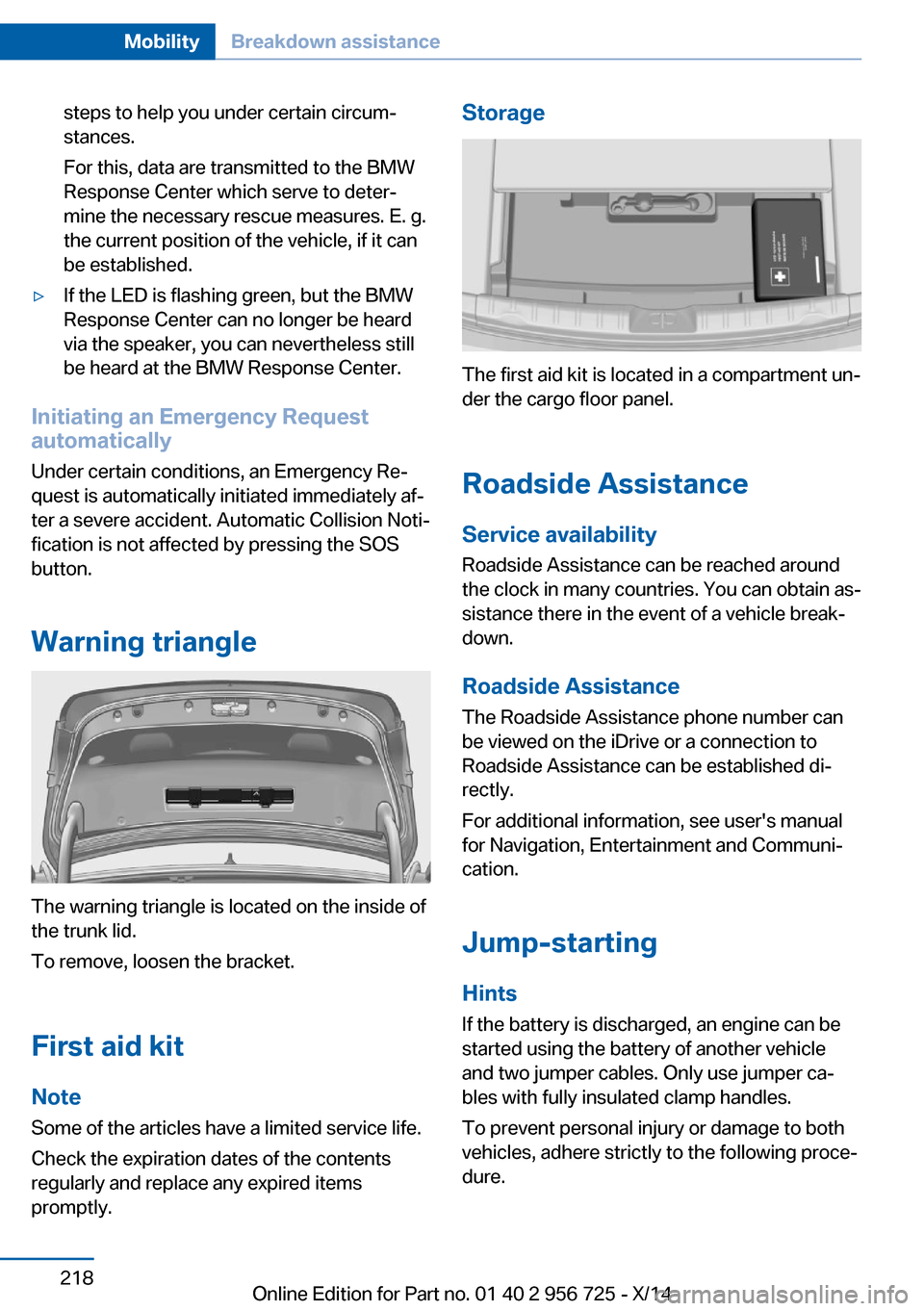
steps to help you under certain circum‐
stances.
For this, data are transmitted to the BMW
Response Center which serve to deter‐
mine the necessary rescue measures. E. g.
the current position of the vehicle, if it can
be established.▷If the LED is flashing green, but the BMW
Response Center can no longer be heard
via the speaker, you can nevertheless still
be heard at the BMW Response Center.
Initiating an Emergency Request
automatically
Under certain conditions, an Emergency Re‐
quest is automatically initiated immediately af‐
ter a severe accident. Automatic Collision Noti‐
fication is not affected by pressing the SOS
button.
Warning triangle
The warning triangle is located on the inside of
the trunk lid.
To remove, loosen the bracket.
First aid kit NoteSome of the articles have a limited service life.
Check the expiration dates of the contents
regularly and replace any expired items
promptly.
Storage
The first aid kit is located in a compartment un‐
der the cargo floor panel.
Roadside Assistance Service availability
Roadside Assistance can be reached around
the clock in many countries. You can obtain as‐
sistance there in the event of a vehicle break‐
down.
Roadside Assistance The Roadside Assistance phone number can
be viewed on the iDrive or a connection to
Roadside Assistance can be established di‐
rectly.
For additional information, see user's manual
for Navigation, Entertainment and Communi‐
cation.
Jump-starting
Hints
If the battery is discharged, an engine can be
started using the battery of another vehicle
and two jumper cables. Only use jumper ca‐
bles with fully insulated clamp handles.
To prevent personal injury or damage to both
vehicles, adhere strictly to the following proce‐
dure.
Seite 218MobilityBreakdown assistance218
Online Edition for Part no. 01 40 2 956 725 - X/14
Page 223 of 247
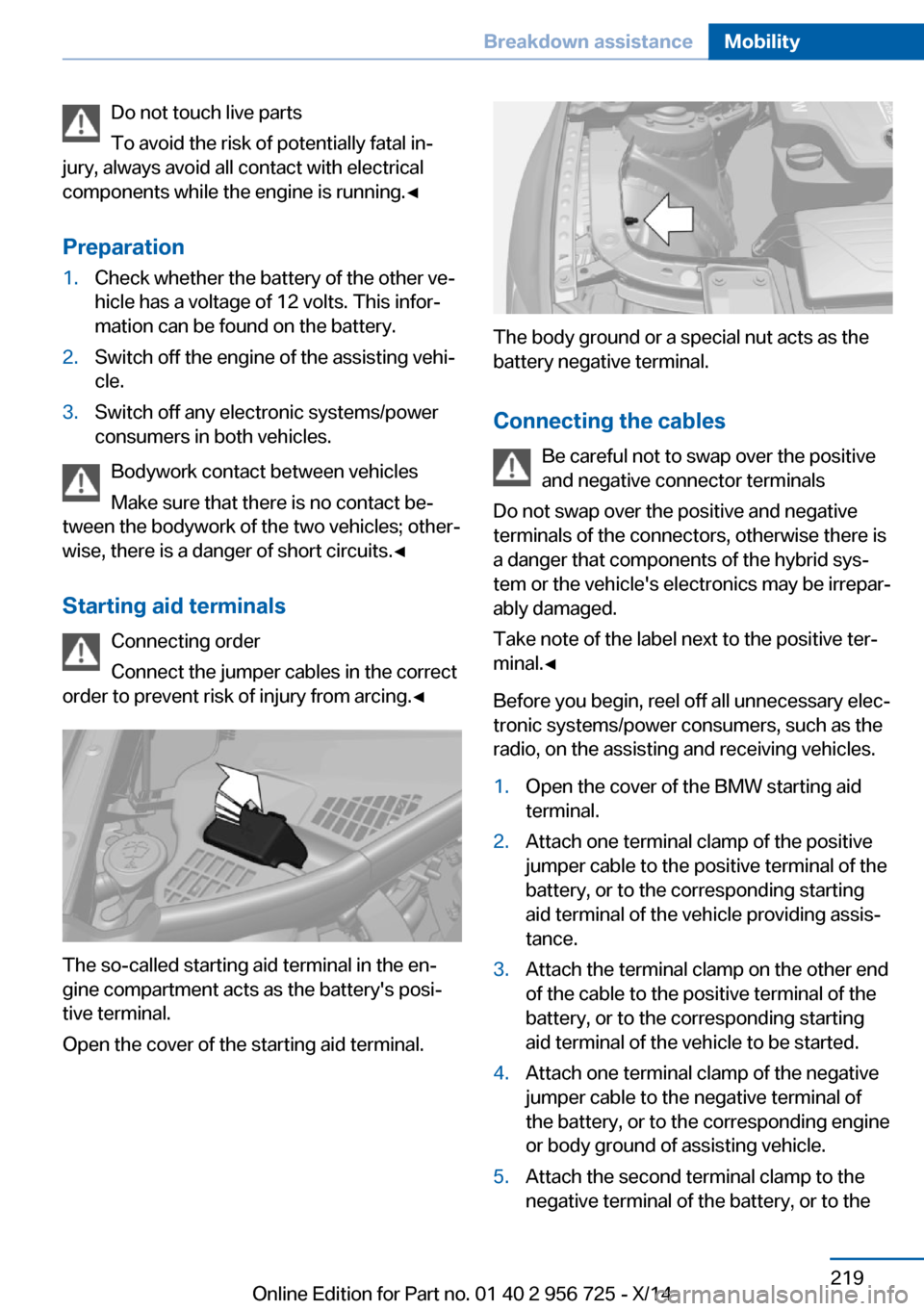
Do not touch live parts
To avoid the risk of potentially fatal in‐
jury, always avoid all contact with electrical
components while the engine is running.◀
Preparation1.Check whether the battery of the other ve‐
hicle has a voltage of 12 volts. This infor‐
mation can be found on the battery.2.Switch off the engine of the assisting vehi‐
cle.3.Switch off any electronic systems/power
consumers in both vehicles.
Bodywork contact between vehicles
Make sure that there is no contact be‐
tween the bodywork of the two vehicles; other‐
wise, there is a danger of short circuits.◀
Starting aid terminals Connecting order
Connect the jumper cables in the correct
order to prevent risk of injury from arcing.◀
The so-called starting aid terminal in the en‐
gine compartment acts as the battery's posi‐
tive terminal.
Open the cover of the starting aid terminal.
The body ground or a special nut acts as the
battery negative terminal.
Connecting the cables Be careful not to swap over the positive
and negative connector terminals
Do not swap over the positive and negative
terminals of the connectors, otherwise there is
a danger that components of the hybrid sys‐
tem or the vehicle's electronics may be irrepar‐
ably damaged.
Take note of the label next to the positive ter‐
minal.◀
Before you begin, reel off all unnecessary elec‐
tronic systems/power consumers, such as the
radio, on the assisting and receiving vehicles.
1.Open the cover of the BMW starting aid
terminal.2.Attach one terminal clamp of the positive
jumper cable to the positive terminal of the
battery, or to the corresponding starting
aid terminal of the vehicle providing assis‐
tance.3.Attach the terminal clamp on the other end
of the cable to the positive terminal of the
battery, or to the corresponding starting
aid terminal of the vehicle to be started.4.Attach one terminal clamp of the negative
jumper cable to the negative terminal of
the battery, or to the corresponding engine
or body ground of assisting vehicle.5.Attach the second terminal clamp to the
negative terminal of the battery, or to theSeite 219Breakdown assistanceMobility219
Online Edition for Part no. 01 40 2 956 725 - X/14
Page 224 of 247
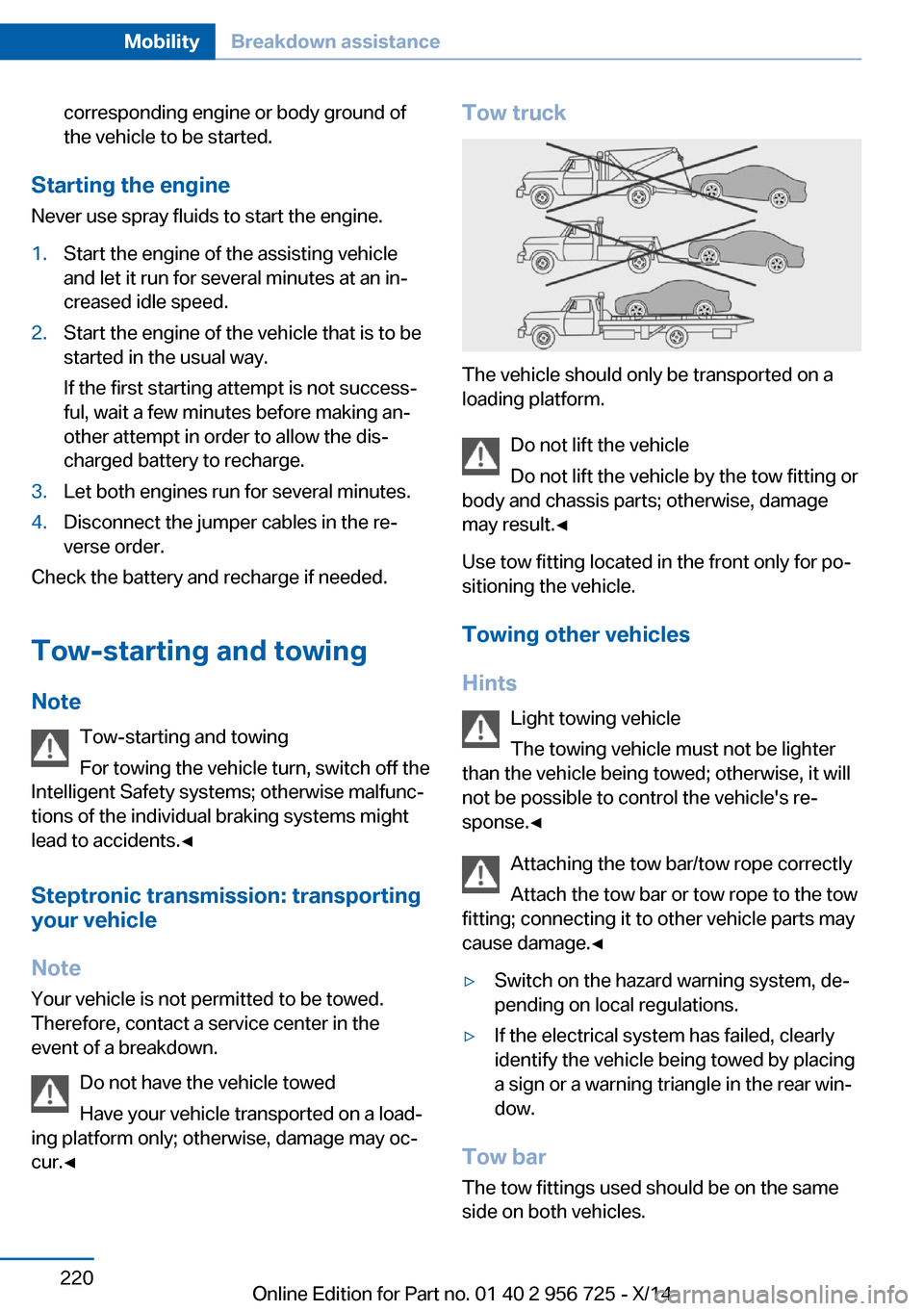
corresponding engine or body ground of
the vehicle to be started.
Starting the engine
Never use spray fluids to start the engine.
1.Start the engine of the assisting vehicle
and let it run for several minutes at an in‐
creased idle speed.2.Start the engine of the vehicle that is to be
started in the usual way.
If the first starting attempt is not success‐
ful, wait a few minutes before making an‐
other attempt in order to allow the dis‐
charged battery to recharge.3.Let both engines run for several minutes.4.Disconnect the jumper cables in the re‐
verse order.
Check the battery and recharge if needed.
Tow-starting and towing Note Tow-starting and towing
For towing the vehicle turn, switch off the
Intelligent Safety systems; otherwise malfunc‐
tions of the individual braking systems might
lead to accidents.◀
Steptronic transmission: transporting
your vehicle
Note Your vehicle is not permitted to be towed.
Therefore, contact a service center in the
event of a breakdown.
Do not have the vehicle towedHave your vehicle transported on a load‐
ing platform only; otherwise, damage may oc‐
cur.◀
Tow truck
The vehicle should only be transported on a
loading platform.
Do not lift the vehicle
Do not lift the vehicle by the tow fitting or
body and chassis parts; otherwise, damage
may result.◀
Use tow fitting located in the front only for po‐
sitioning the vehicle.
Towing other vehicles
Hints Light towing vehicle
The towing vehicle must not be lighter
than the vehicle being towed; otherwise, it will
not be possible to control the vehicle's re‐
sponse.◀
Attaching the tow bar/tow rope correctly
Attach the tow bar or tow rope to the tow
fitting; connecting it to other vehicle parts may
cause damage.◀
▷Switch on the hazard warning system, de‐
pending on local regulations.▷If the electrical system has failed, clearly
identify the vehicle being towed by placing
a sign or a warning triangle in the rear win‐
dow.
Tow bar
The tow fittings used should be on the same
side on both vehicles.
Seite 220MobilityBreakdown assistance220
Online Edition for Part no. 01 40 2 956 725 - X/14
Page 238 of 247
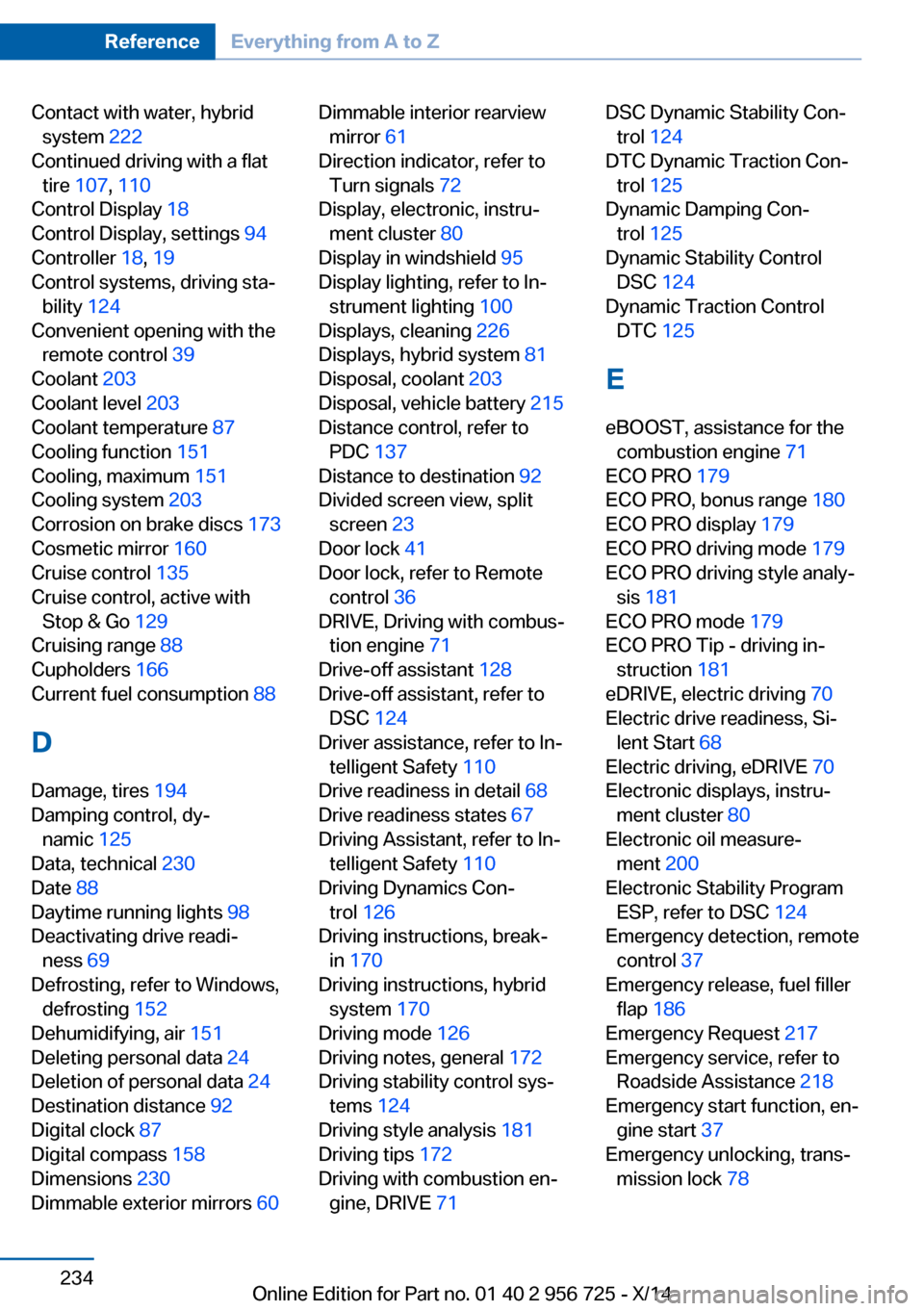
Contact with water, hybridsystem 222
Continued driving with a flat tire 107 , 110
Control Display 18
Control Display, settings 94
Controller 18, 19
Control systems, driving sta‐ bility 124
Convenient opening with the remote control 39
Coolant 203
Coolant level 203
Coolant temperature 87
Cooling function 151
Cooling, maximum 151
Cooling system 203
Corrosion on brake discs 173
Cosmetic mirror 160
Cruise control 135
Cruise control, active with Stop & Go 129
Cruising range 88
Cupholders 166
Current fuel consumption 88
D
Damage, tires 194
Damping control, dy‐ namic 125
Data, technical 230
Date 88
Daytime running lights 98
Deactivating drive readi‐ ness 69
Defrosting, refer to Windows, defrosting 152
Dehumidifying, air 151
Deleting personal data 24
Deletion of personal data 24
Destination distance 92
Digital clock 87
Digital compass 158
Dimensions 230
Dimmable exterior mirrors 60 Dimmable interior rearview
mirror 61
Direction indicator, refer to Turn signals 72
Display, electronic, instru‐ ment cluster 80
Display in windshield 95
Display lighting, refer to In‐ strument lighting 100
Displays, cleaning 226
Displays, hybrid system 81
Disposal, coolant 203
Disposal, vehicle battery 215
Distance control, refer to PDC 137
Distance to destination 92
Divided screen view, split screen 23
Door lock 41
Door lock, refer to Remote control 36
DRIVE, Driving with combus‐ tion engine 71
Drive-off assistant 128
Drive-off assistant, refer to DSC 124
Driver assistance, refer to In‐ telligent Safety 110
Drive readiness in detail 68
Drive readiness states 67
Driving Assistant, refer to In‐ telligent Safety 110
Driving Dynamics Con‐ trol 126
Driving instructions, break- in 170
Driving instructions, hybrid system 170
Driving mode 126
Driving notes, general 172
Driving stability control sys‐ tems 124
Driving style analysis 181
Driving tips 172
Driving with combustion en‐ gine, DRIVE 71 DSC Dynamic Stability Con‐
trol 124
DTC Dynamic Traction Con‐ trol 125
Dynamic Damping Con‐ trol 125
Dynamic Stability Control DSC 124
Dynamic Traction Control DTC 125
E eBOOST, assistance for the combustion engine 71
ECO PRO 179
ECO PRO, bonus range 180
ECO PRO display 179
ECO PRO driving mode 179
ECO PRO driving style analy‐ sis 181
ECO PRO mode 179
ECO PRO Tip - driving in‐ struction 181
eDRIVE, electric driving 70
Electric drive readiness, Si‐ lent Start 68
Electric driving, eDRIVE 70
Electronic displays, instru‐ ment cluster 80
Electronic oil measure‐ ment 200
Electronic Stability Program ESP, refer to DSC 124
Emergency detection, remote control 37
Emergency release, fuel filler flap 186
Emergency Request 217
Emergency service, refer to Roadside Assistance 218
Emergency start function, en‐ gine start 37
Emergency unlocking, trans‐ mission lock 78 Seite 234ReferenceEverything from A to Z234
Online Edition for Part no. 01 40 2 956 725 - X/14
Page 239 of 247
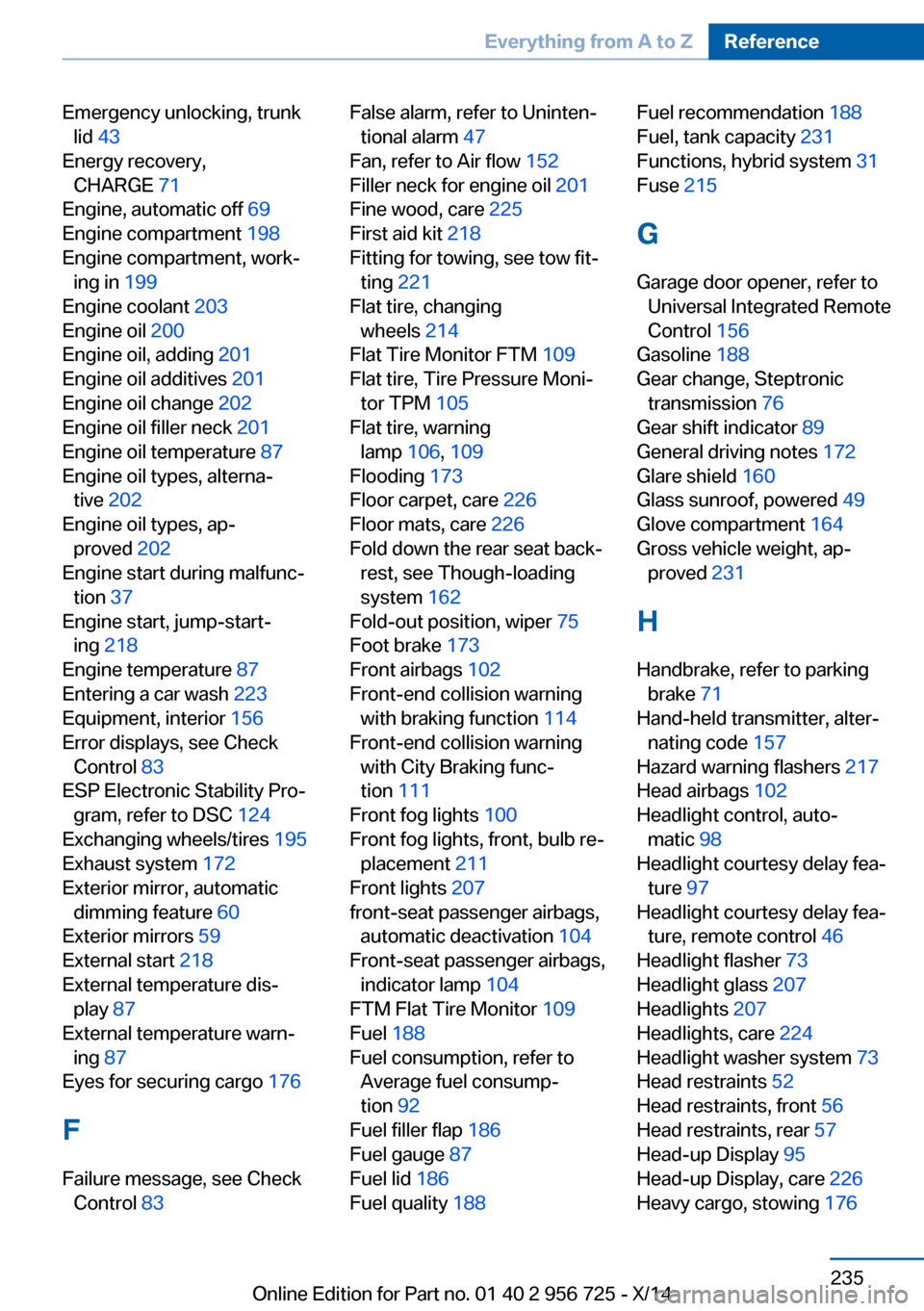
Emergency unlocking, trunklid 43
Energy recovery, CHARGE 71
Engine, automatic off 69
Engine compartment 198
Engine compartment, work‐ ing in 199
Engine coolant 203
Engine oil 200
Engine oil, adding 201
Engine oil additives 201
Engine oil change 202
Engine oil filler neck 201
Engine oil temperature 87
Engine oil types, alterna‐ tive 202
Engine oil types, ap‐ proved 202
Engine start during malfunc‐ tion 37
Engine start, jump-start‐ ing 218
Engine temperature 87
Entering a car wash 223
Equipment, interior 156
Error displays, see Check Control 83
ESP Electronic Stability Pro‐ gram, refer to DSC 124
Exchanging wheels/tires 195
Exhaust system 172
Exterior mirror, automatic dimming feature 60
Exterior mirrors 59
External start 218
External temperature dis‐ play 87
External temperature warn‐ ing 87
Eyes for securing cargo 176
F
Failure message, see Check Control 83 False alarm, refer to Uninten‐
tional alarm 47
Fan, refer to Air flow 152
Filler neck for engine oil 201
Fine wood, care 225
First aid kit 218
Fitting for towing, see tow fit‐ ting 221
Flat tire, changing wheels 214
Flat Tire Monitor FTM 109
Flat tire, Tire Pressure Moni‐ tor TPM 105
Flat tire, warning lamp 106, 109
Flooding 173
Floor carpet, care 226
Floor mats, care 226
Fold down the rear seat back‐ rest, see Though-loading
system 162
Fold-out position, wiper 75
Foot brake 173
Front airbags 102
Front-end collision warning with braking function 114
Front-end collision warning with City Braking func‐
tion 111
Front fog lights 100
Front fog lights, front, bulb re‐ placement 211
Front lights 207
front-seat passenger airbags, automatic deactivation 104
Front-seat passenger airbags, indicator lamp 104
FTM Flat Tire Monitor 109
Fuel 188
Fuel consumption, refer to Average fuel consump‐
tion 92
Fuel filler flap 186
Fuel gauge 87
Fuel lid 186
Fuel quality 188 Fuel recommendation 188
Fuel, tank capacity 231
Functions, hybrid system 31
Fuse 215
G
Garage door opener, refer to Universal Integrated Remote
Control 156
Gasoline 188
Gear change, Steptronic transmission 76
Gear shift indicator 89
General driving notes 172
Glare shield 160
Glass sunroof, powered 49
Glove compartment 164
Gross vehicle weight, ap‐ proved 231
H
Handbrake, refer to parking brake 71
Hand-held transmitter, alter‐ nating code 157
Hazard warning flashers 217
Head airbags 102
Headlight control, auto‐ matic 98
Headlight courtesy delay fea‐ ture 97
Headlight courtesy delay fea‐ ture, remote control 46
Headlight flasher 73
Headlight glass 207
Headlights 207
Headlights, care 224
Headlight washer system 73
Head restraints 52
Head restraints, front 56
Head restraints, rear 57
Head-up Display 95
Head-up Display, care 226
Heavy cargo, stowing 176 Seite 235Everything from A to ZReference235
Online Edition for Part no. 01 40 2 956 725 - X/14